Standards Worldwide
Standards Worldwide
Phone +49 30 58885700-07

Standard [CURRENT]
ASTM E 690:2015
Standard Practice for In Situ Electromagnetic (Eddy Current) Examination of Nonmagnetic Heat Exchanger Tubes
- German title
- Richtlinie über die elektromagnetische Prüfung (Wirbelstromprüfung) von nichtmagnetischen Wärmetauscherrohren mit Innendurchlaufspulen
- Publication date
- 2015 reapproved: 2020
- Original language
- English
- Pages
- 5
- Publication date
- 2015 reapproved: 2020
- Original language
- English
- Pages
- 5
- DOI
- https://dx.doi.org/10.1520/E0690-15R20
Product information on this site:
Quick delivery via download or delivery service
Buy securely with a credit card or pay upon receipt of invoice
All transactions are encrypted
Short description
1.1 This practice describes procedures to be followed during eddy current examination (using an internal, probe-type, coil assembly) of nonmagnetic tubing that has been installed in a heat exchanger. The procedure recognizes both the unique problems of implementing an eddy current examination of installed tubing, and the indigenous forms of tube-wall deterioration which may occur during this type of service. The document primarily addresses scheduled maintenance inspection of heat exchangers, but can also be used by manufacturers of heat exchangers, either to examine the condition of the tubes after installation, or to establish baseline data for evaluating subsequent performance of the product after exposure to various environmental conditions. The ultimate purpose is the detection and evaluation of particular types of tube integrity degradation which could result in in-service tube failures. 1.2 This practice does not establish acceptance criteria; they must be specified by the using parties. 1.3 This standard does not purport to address all of the safety concerns, if any, associated with its use. It is the responsibility of the user of this standard to establish appropriate safety and health practices and determine the applicability of regulatory limitations prior to use.
ICS
27.060.30
DOI
https://dx.doi.org/10.1520/E0690-15R20
Also available in
Loading recommended items...
Loading recommended items...
Loading recommended items...
Loading recommended items...
